高考语法讲义(二十)主谓一致
高中英语语法:高中英语主谓一致详解

高中英语语法:高中英语主谓一致详解在高中英语语法中,主谓一致是一个重要且常考的知识点。
它要求主语和谓语在人称和数上保持一致,看似简单,实则有许多细节需要我们注意。
首先,我们来了解一下什么是主谓一致。
主谓一致指的是句子的主语和谓语在人称、数和时态上的协调配合。
简单来说,就是主语是单数,谓语动词也要用单数形式;主语是复数,谓语动词就用复数形式。
一、语法一致原则这是主谓一致中最基本的原则。
当主语是单数名词、不可数名词、动词不定式、动名词或单个从句时,谓语动词用单数形式。
例如:“The book is very interesting”(这本书很有趣。
)“Smoking is bad for health”(吸烟有害健康。
)当主语是复数名词时,谓语动词用复数形式。
比如:“These books are mine”(这些书是我的。
)需要特别注意的是,当主语是由 and 连接的两个或多个名词时,如果表示的是不同的人或物,谓语动词用复数;但如果表示的是同一人、同一物或同一概念时,谓语动词用单数。
例如:“The teacher and writeris coming”(这位教师兼作家要来了。
)这里的“teacher and writer”指的是同一个人,所以谓语动词用单数;而“The teacher and the writer arecoming”(这位教师和这位作家要来了。
)这里的“teacher”和“writer”是不同的两个人,谓语动词用复数。
二、意义一致原则有时候,主语的形式是单数,但意义是复数;或者主语形式是复数,但意义是单数。
在这种情况下,谓语动词的形式要根据主语的实际意义来决定。
例如,集合名词如 family(家庭)、class(班级)、team(团队)等,如果强调的是整体,谓语动词用单数;如果强调的是个体成员,谓语动词用复数。
比如:“My family is a big one”(我的家庭是个大家庭。
高中英语2025届高考语法复习句法知识讲解(主谓一致+动词时态+助动词)

高考英语语法复习句法知识讲解一、主谓一致在英文中,谓语的形式要与主语保持一致。
比如,你、我、他是学生,中文“是”字是一样的,只有主语不同。
英文的动词要根据主语不同而改变:I am,you are,he is。
主谓一致有三大原则:语法一致,意义一致,就近一致。
(一)语法一致名词是单数,谓语动词是单数。
不可数名词、集体名词、动词不定式、动名词等,谓语动词也用单数。
Knowledge is power. 知识就是力量。
The team is playing well. 这个团队表现得很好。
To see is to believe. 眼见为实。
Swimming is good exercise. 游泳是一项很好的运动。
记住:绝大多数都用单数,只有明确的复数名词,谓语动词才用复数。
My parents are teachers. 我的父母都是老师。
The shoes are all right. 这些鞋子很合适。
鞋、裤子、眼镜,只能是复数,如果前面加上“一双”“一条”,后面的动词就是单数。
A pair of glasses is very expensive. 一副眼镜很贵。
要想搞清楚谓语用单数还是复数,一定要准确锁定主语。
All except me in my family are going to the park. 很显然,all才是真正的主语,所以是复数。
She as well as the other girls is reading a book. 在这里,She才是真正的主语,所以是单数。
"more than one +名词"作主语时,谓语动词常用单数。
例如:More than one teacher gets the flowers."half of, the rest of, most of, all of, 百分数/分数+of +名词"作主语时,谓语动词形式根据of后的名词而定。
高中英语主谓一致讲解(整理版)
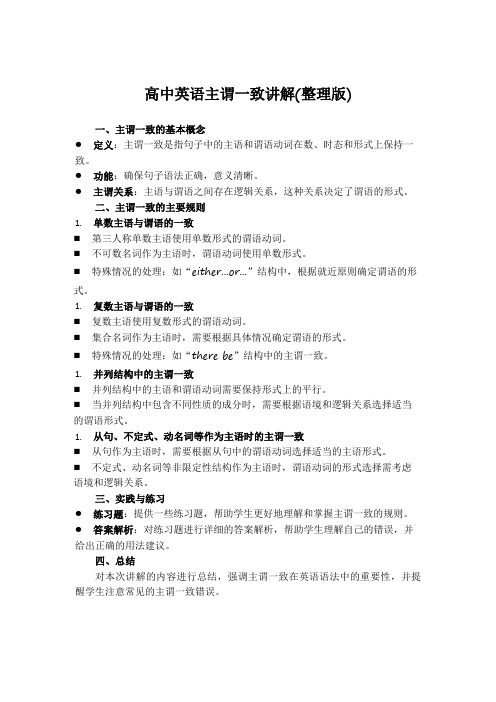
高中英语主谓一致讲解(整理版)
一、主谓一致的基本概念
●定义:主谓一致是指句子中的主语和谓语动词在数、时态和形式上保持一致。
●功能:确保句子语法正确,意义清晰。
●主谓关系:主语与谓语之间存在逻辑关系,这种关系决定了谓语的形式。
二、主谓一致的主要规则
1.单数主语与谓语的一致
⏹第三人称单数主语使用单数形式的谓语动词。
⏹不可数名词作为主语时,谓语动词使用单数形式。
⏹特殊情况的处理:如“either...or...”结构中,根据就近原则确定谓语的形式。
1.复数主语与谓语的一致
⏹复数主语使用复数形式的谓语动词。
⏹集合名词作为主语时,需要根据具体情况确定谓语的形式。
⏹特殊情况的处理:如“there be”结构中的主谓一致。
1.并列结构中的主谓一致
⏹并列结构中的主语和谓语动词需要保持形式上的平行。
⏹当并列结构中包含不同性质的成分时,需要根据语境和逻辑关系选择适当的谓语形式。
1.从句、不定式、动名词等作为主语时的主谓一致
⏹从句作为主语时,需要根据从句中的谓语动词选择适当的主语形式。
⏹不定式、动名词等非限定性结构作为主语时,谓语动词的形式选择需考虑语境和逻辑关系。
三、实践与练习
●练习题:提供一些练习题,帮助学生更好地理解和掌握主谓一致的规则。
●答案解析:对练习题进行详细的答案解析,帮助学生理解自己的错误,并给出正确的用法建议。
四、总结
对本次讲解的内容进行总结,强调主谓一致在英语语法中的重要性,并提醒学生注意常见的主谓一致错误。
高考英语语法专题 主谓一致 课件

+谓语动词
neither A nor B 既不是A也不是B
either A or B 不是A就是B
注意:1. There be+ A and B 有A和B:与A保持一致
与B保持一致
2. Both A and B A和B都 :要看成复数
有题有真相: 1. Either you or I am (be) wrong. 2. There is (be) a book and some pens on the desk. 3. Not only you but also he is (be) to be blame. 4. Not noly I but also Jane and Mary are (be) tired of having one exam after another.
把主语看做 复数 单数 复数 单数 单数 复数 单数 复数
需要区别对待的的考点
考点 5 6
主语形式
把主语看做
冠词+A and 冠词 +B, 表示不同的人或物
3. The famous musician, as well as his students, had (have) been invited to perform at the opening ceremony of the 2012 Taipei Flower Expo.
常看成单数形式的6大考点
5
no A and no B (没有...和....)
many a A and many a B
单数
6
表时间,金钱,距离,重量的复数名词 (miles, dollars, pounds, kilograms, kilometres, second, hours,years等)
高考主谓一致知识点归纳
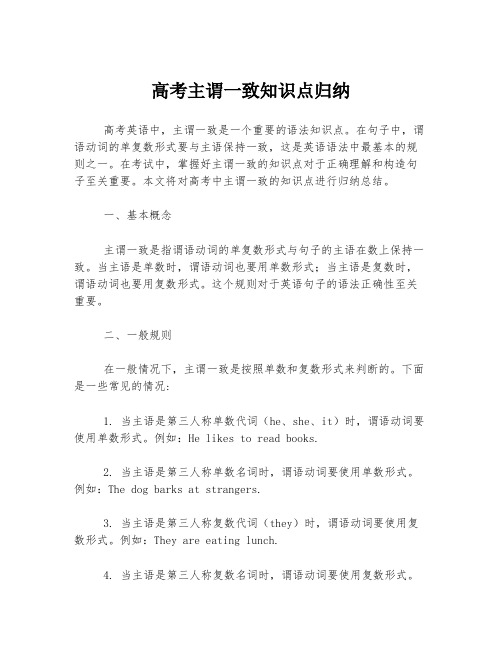
高考主谓一致知识点归纳高考英语中,主谓一致是一个重要的语法知识点。
在句子中,谓语动词的单复数形式要与主语保持一致,这是英语语法中最基本的规则之一。
在考试中,掌握好主谓一致的知识点对于正确理解和构造句子至关重要。
本文将对高考中主谓一致的知识点进行归纳总结。
一、基本概念主谓一致是指谓语动词的单复数形式与句子的主语在数上保持一致。
当主语是单数时,谓语动词也要用单数形式;当主语是复数时,谓语动词也要用复数形式。
这个规则对于英语句子的语法正确性至关重要。
二、一般规则在一般情况下,主谓一致是按照单数和复数形式来判断的。
下面是一些常见的情况:1. 当主语是第三人称单数代词(he、she、it)时,谓语动词要使用单数形式。
例如:He likes to read books.2. 当主语是第三人称单数名词时,谓语动词要使用单数形式。
例如:The dog barks at strangers.3. 当主语是第三人称复数代词(they)时,谓语动词要使用复数形式。
例如:They are eating lunch.4. 当主语是第三人称复数名词时,谓语动词要使用复数形式。
例如:The girls play soccer every Saturday.三、特殊情况除了一般规则外,还有一些特殊情况需要特别注意。
下面是一些常见的特殊情况及解释:1. 连系动词和主语一致。
当谓语动词是“be”等连系动词时,其形式要与主语保持一致。
例如:She is a doctor.2. 由“there”引导的句子。
当句子以“There”作为形式主语时,谓语动词的形式要与后面的真正主语保持一致。
例如:There are two apples on the table.3. 复合主语的一致性。
当句子中有两个或更多的主语时,谓语动词的形式要与紧靠它的主语保持一致。
例如:The cat and the dog are playing in the garden.四、注意事项在考试中,还有一些需要特别注意的事项:1. 特殊名词的复数形式。
高三英语语法讲解----主谓一致

一、定义:主谓一致即谓语动词在人称和数上要和主语保持一致,主谓一致包括 语法一致、意义一致和就近一致. (1)语法一致:谓语动词在单复数形式上要和主语保持一致 (2)意义一致:谓语动词要和主语意义上的单复数保持一致 (3)就近一致:谓语动词要和靠近它的主语部分保持一致
02 related knowledge
二、意义一致
(4)“many a+单数名词”作主语时,谓语动词用单数。 Many a child was playing there. 很多孩子在那边玩 (5)在定语从句中,关系代词如果在从句中作主语,根据先行词决定 从句谓语动词的单复数;在“one of+复数名词+who/that/which”引导 的从句中,谓语动词用复数;但之前有the(only)等修饰语时,从句中的 谓语动词用单数。 Mary is the only one of the students in our school who has ever been to China.
一、语法一致
(6)what引导的从句作主语时,谓语动词的单复数取决于作表语的名 词的单复数。 What surprised me most was his attitude towards his study. 最令我惊讶的是他对学习的态度 What her father left her are only some books. 她父亲留给她的只有一些书 (7)such作主语时,谓语动词的单复数形式要根据其意义而定。 Such is Stephen Hawking,who has suffered a great deal but achieved so much. 这就是史蒂芬·霍金,他经受了很多痛苦但也取得了许多成就 Such are the results we have got. 这些就是我们所取得的成果
英语主谓一致讲解ppt课件

作单数用 ) These kinds of apple(s) are sweet . (总作复数用) Apples of this kind are sweet . (总作复数用)
经营者提供商品或者服务有欺诈行为 的,应 当按照 消费者 的要求 增加赔 偿其受 到的损 失,增 加赔偿 的金额 为消费 者购买 商品的 价款或 接受服 务的费 用
41. Early to bed and early to rise ______ a man healthy, happy and wise.
经营者提供商品或者服务有欺诈行为 的,应 当按照 消费者 的要求 增加赔 偿其受 到的损 失,增 加赔偿 的金额 为消费 者购买 商品的 价款或 接受服 务的费 用
什么是主谓一致?
主谓一致:英语句子中,主语的“人称”和 “数”要限制、决定谓语动词的形式变化, 这就叫“主谓一致”关系。
它通常依据三项原则: 1)语法一致 (必考) 2)意义一致; 3)就近一致。(必考)
______ some history, enough at least, to survive in the world. a. knows b. know c. is known d. are known
经营者提供商品或者服务有欺诈行为 的,应 当按照 消费者 的要求 增加赔 偿其受 到的损 失,增 加赔偿 的金额 为消费 者购买 商品的 价款或 接受服 务的费 用
高中英语知识点归纳主谓一致和主谓语序的语法规则

高中英语知识点归纳主谓一致和主谓语序的语法规则一、主谓一致的语法规则主谓一致是指主语和谓语动词在人称和数上要保持一致。
以下是主谓一致的几个常见规则:1. 单数主语和单数谓语动词一致:例如,“The dog barks”(这条狗叫)。
2. 复数主语和复数谓语动词一致:例如,“The dogs bark”(这些狗叫)。
3. 不可数名词的主语和单数谓语动词一致:例如,“The water is cold”(水很冷)。
4. 有些特殊的复数名词作主语时,谓语动词要用单数形式。
这包括家庭成员名词“family”、“team”、“audience”等:例如,“My family is going on vacation”(我的家人要去度假)。
5. 当主语包括不同人称时,使用谓语动词的第一人称的复数形式:例如,“Tom and I are going to the movies”(汤姆和我要去看电影)。
6. 当主语为某个整体时,谓语动词与之保持一致:例如,“The crew is preparing for takeoff”(机组人员正在准备起飞)。
7. 当主语中包括“each”、“every”、“either”、“neither”、“everyone”、“nobody”等词时,谓语动词用单数形式:例如,“Every student has to submit their homework”(每个学生都必须提交他们的作业)。
二、主谓语序的语法规则主谓语序指的是主语和谓语动词的顺序要保持一致。
以下是主谓语序的几个常见规则:1. 在陈述句中,主语通常位于谓语动词之前:例如,“She is a teacher”(她是一名老师)。
2. 在疑问句中,将谓语动词放在主语之前:例如,“Are you hungry?”(你饿了吗?)。
3. 在祈使句中,主语通常省略,谓语动词单独出现:例如,“Sit down”(坐下)。
4. 在条件句中,主语通常位于谓语动词之前:例如,“If it rains, we will stay indoors”(如果下雨,我们就呆在室内)。
主谓一致知识点高考
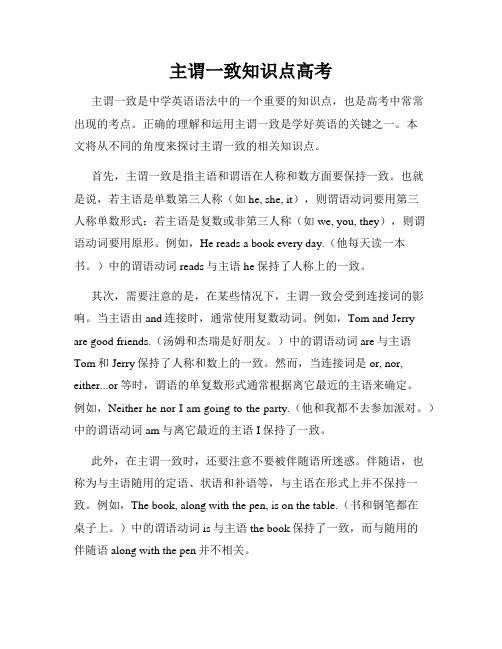
主谓一致知识点高考主谓一致是中学英语语法中的一个重要的知识点,也是高考中常常出现的考点。
正确的理解和运用主谓一致是学好英语的关键之一。
本文将从不同的角度来探讨主谓一致的相关知识点。
首先,主谓一致是指主语和谓语在人称和数方面要保持一致。
也就是说,若主语是单数第三人称(如he, she, it),则谓语动词要用第三人称单数形式;若主语是复数或非第三人称(如we, you, they),则谓语动词要用原形。
例如,He reads a book every day.(他每天读一本书。
)中的谓语动词reads与主语he保持了人称上的一致。
其次,需要注意的是,在某些情况下,主谓一致会受到连接词的影响。
当主语由and连接时,通常使用复数动词。
例如,Tom and Jerryare good friends.(汤姆和杰瑞是好朋友。
)中的谓语动词are与主语Tom和Jerry保持了人称和数上的一致。
然而,当连接词是or, nor, either...or等时,谓语的单复数形式通常根据离它最近的主语来确定。
例如,Neither he nor I am going to the party.(他和我都不去参加派对。
)中的谓语动词am与离它最近的主语I保持了一致。
此外,在主谓一致时,还要注意不要被伴随语所迷惑。
伴随语,也称为与主语随用的定语、状语和补语等,与主语在形式上并不保持一致。
例如,The book, along with the pen, is on the table.(书和钢笔都在桌子上。
)中的谓语动词is与主语the book保持了一致,而与随用的伴随语along with the pen并不相关。
此外,在使用there be句型时,主谓一致要根据后面的真正主语来确定。
例如,There is a book on the desk.(桌子上有一本书。
)中的谓语动词is与主语a book保持了一致。
总之,正确理解和运用主谓一致是掌握英语语法的基础之一。
高中英语主谓一致讲解及练习
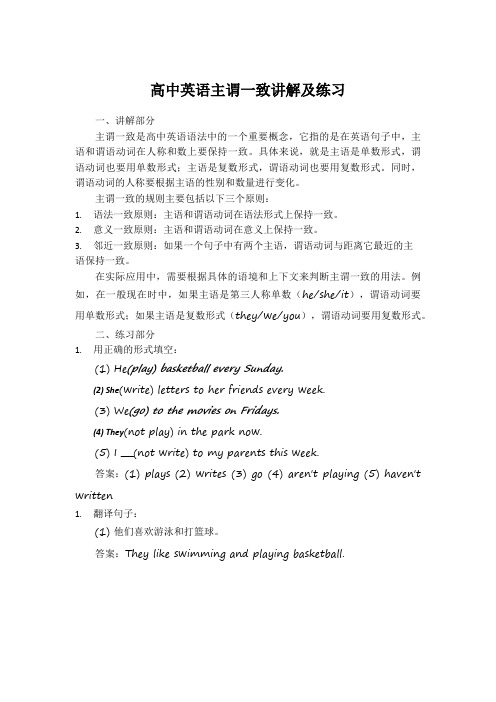
高中英语主谓一致讲解及练习一、讲解部分主谓一致是高中英语语法中的一个重要概念,它指的是在英语句子中,主语和谓语动词在人称和数上要保持一致。
具体来说,就是主语是单数形式,谓语动词也要用单数形式;主语是复数形式,谓语动词也要用复数形式。
同时,谓语动词的人称要根据主语的性别和数量进行变化。
主谓一致的规则主要包括以下三个原则:1.语法一致原则:主语和谓语动词在语法形式上保持一致。
2.意义一致原则:主语和谓语动词在意义上保持一致。
3.邻近一致原则:如果一个句子中有两个主语,谓语动词与距离它最近的主语保持一致。
在实际应用中,需要根据具体的语境和上下文来判断主谓一致的用法。
例如,在一般现在时中,如果主语是第三人称单数(he/she/it),谓语动词要用单数形式;如果主语是复数形式(they/we/you),谓语动词要用复数形式。
二、练习部分1.用正确的形式填空:(1) He(play) basketball every Sunday.(2) She(write) letters to her friends every week.(3) We(go) to the movies on Fridays.(4) They(not play) in the park now.(5) I ___(not write) to my parents this week.答案:(1) plays (2) writes (3) go (4) aren't playing (5) haven't written1.翻译句子:(1) 他们喜欢游泳和打篮球。
答案:They like swimming and playing basketball.。
高考英语语法解析之主谓一致
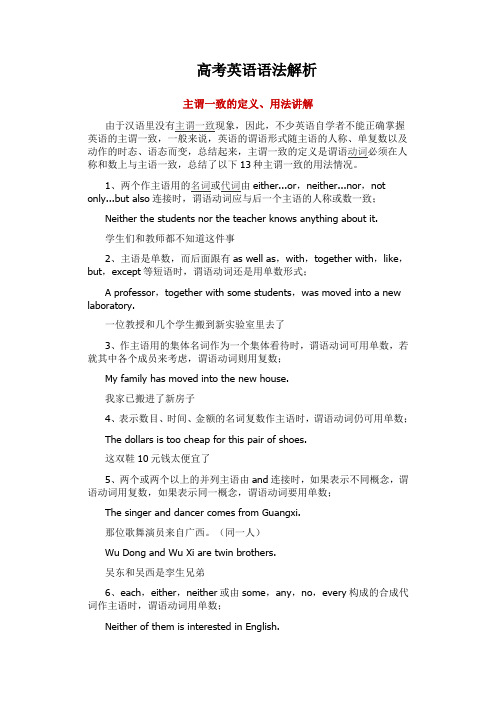
高考英语语法解析主谓一致的定义、用法讲解由于汉语里没有主谓一致现象,因此,不少英语自学者不能正确掌握英语的主谓一致,一般来说,英语的谓语形式随主语的人称、单复数以及动作的时态、语态而变,总结起来,主谓一致的定义是谓语动词必须在人称和数上与主语一致,总结了以下13种主谓一致的用法情况。
1、两个作主语用的名词或代词由either...or,neither...nor,not only...but also连接时,谓语动词应与后一个主语的人称或数一致;Neither the students nor the teacher knows anything about it.学生们和教师都不知道这件事2、主语是单数,而后面跟有as well as,with,together with,like,but,except等短语时,谓语动词还是用单数形式;A professor,together with some students,was moved into a new laboratory.一位教授和几个学生搬到新实验室里去了3、作主语用的集体名词作为一个集体看待时,谓语动词可用单数,若就其中各个成员来考虑,谓语动词则用复数;My family has moved into the new house.我家已搬进了新房子4、表示数目、时间、金额的名词复数作主语时,谓语动词仍可用单数;The dollars is too cheap for this pair of shoes.这双鞋10元钱太便宜了5、两个或两个以上的并列主语由and连接时,如果表示不同概念,谓语动词用复数,如果表示同一概念,谓语动词要用单数;The singer and dancer comes from Guangxi.那位歌舞演员来自广西。
(同一人)Wu Dong and Wu Xi are twin brothers.吴东和吴西是孪生兄弟6、each,either,neither或由some,any,no,every构成的合成代词作主语时,谓语动词用单数;Neither of them is interested in English.他们两人都对英语不感兴趣7、none作主语时,谓语动词可用单数或复数;None knows(或know)a great deal about this experiment.没有一个人对这项实验知道得很多8、代词what,who,which,any,all,most,more等作主语时,谓语动词用单数还是复数主要由它们所代替的意义决定;All of the students have seen the film.所有的学生都看过这部电影9、people,police,cattle等作主语时,谓语动词用复数;The people in the city are very friendly.那个城市的人很友好10、用“every,each,no或many a(或a great deal of)+ 单数名词”作主语时,谓语动词用单数,而“a great many(或a great number of 等)+复数名词”作主语时,谓语动词则用复数;Many a student and teacher is watching the football match.许多学生和老师正在观看足球比赛11、有些名词只有复数形式,可根据谓语动词单复数来判别其主语所表示的事物的实际单复数;The steel works in the country produce more steel than those in that country.这个国家的钢厂比那个国家的钢厂生产的钢要多12、“there be+并列主语”和“here be+并列主语”结构中的谓语形式,一般应与并列主语中的第一个主语的数一致;There are some books and a pen on the desk.桌上有些书和一支钢笔13、“the+形容词/-ed分词”这一表示一类人的结构作主语时,谓语动词用复数,这种结构表示物时,谓语动词用单数;The young are required to respect the old.年轻人应该尊敬老年人The good in him outweighs the bad.他身上的有点多过缺点定语从句与名词性从句的主谓一致主谓一致就是指在英语句子中,主语和谓语在人称和数的方面应保持一致。
高考英语语法主谓一致讲义

主谓一致主谓一致:指句子的谓语受主语支配,随着主语单复数形式的变化而变化。
一、三个原则1. 意义一致:根据句子主语的含义(单复数意义)来确定谓语动词的变化。
The professor and writer is is invited to many universities to give lectures.The police are trying to search for the thief on the hill.2. 语法一致:语法形式上保持一致,即单数主语要用单数谓语动词,复数主语要用复数谓语动词,不可数名词作主语时,谓语用单数形式。
My bike is under the tree. These books are old.3.就近原则:主语由两个或两个以上的名词或代词构成,谓语动词的单复数形式应与紧邻的名词或代词保持一致Either my father or brother is coming. Not only you but also they are good students.二、并列结构作主语1、由and或both... and连接两个名词、代词作主语,表示不同的人或事物时,句子的谓语用复数。
在意义上指同一人、同一物或同一概念时,谓语动词用单数。
John and Mike are good friends.The famous singer and dancer is coming to Chongqing.2、every....and every , each...and each..., no....and no.... 做主语时谓语用单数。
Each boy and each girl has been invited to the party.3、not....but, not only...but also..., or, either....or, neither...nor, there be、Here be 句型谓语就近原则Neither you nor I am fit for the work.There is a pen,a pencil,a knife and three books on the desk.Here are some flowers and a card.三、单一主语:由一个中心词或短语充当的主语不定代词作主语:1.当作主语的名词前有each,neither,either,every修饰或each,neither,either作主语时,谓语动词用单数。
高考英语语法主谓一致讲解 (共23张PPT)

什么是主谓一致?
主谓一致是指谓语动词必须和 _主__语_ 在__人_称__和数上保持一致.
三个基本原则:
♠就近/就远原则 ♠语法一致原则 ♠意义一致原则
★Ⅰ1.就近原则
or , either…or , neither…nor, not only …but also…, there be…./here be……
newspapers that ___w__a_s__ (be) newly published last month.
6. The manager and designer ___i_s ____ (be) to give some suggestions for the design of the new building in a while.
A. is offered B. has offered C. are offered D. have offered 3.Either the headmaster or you ____ the prizes to these
gifted students at the meeting. A. is handed out B. are handed out C. are to hand out D. is to hand out
(1) Ten dollars _h_a_s(have) been wasted.
(2) Two thousand miles _i_s_ (be)a long distance. 2、the + adj. 表一类人,谓语动词用__复__数_.
表抽象概念的事,谓语动词用_单__数__. (1)In China,the old _a_re_ (be)taken good care of. (2) The unknown __is_ always something to be feared.
高考英语语法复习主谓一致课件

当 “each / every + 单数名词 + and each / every +单数名词” 结构作主语时
① During the holidays every train and ship _i_s_crowded.
② each boy and each girl _i_s_(have) a book.
Neither room__is__ large enough.
4. such 作主语时,采用意义一致的原则。 ①Such _i_s the situation we were facing.
②Such __a_re__ his words.
1.and, both...and 连结的并列主语 1)若代表两个不同的事物, 用复数形式. ①Both rice and cottonቤተ መጻሕፍቲ ባይዱ__g_ro_w__in the
3.集合名词作主语
(1)有些集合名词 machinery, equipment, furniture, jewellery clothing 表单数概念, 用单数动词。
① The furniture in the exhibition hall _i_s_ pleasant to look at.
1) There are two teachers and a student under the tree. 2) There is a student and two teachers under the tree. 3) Not only the students but also the teacher enjoys listening to the music.
1945.
the Olympic Games 可用单数也可用复数
2023届高考英语语法之主谓一致语法一致与形式一致原则讲义
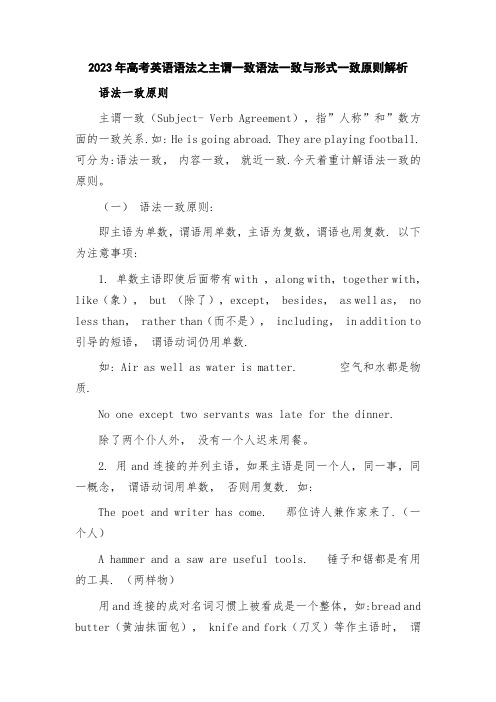
2023年高考英语语法之主谓一致语法一致与形式一致原则解析语法一致原则主谓一致(Subject- Verb Agreement),指”人称”和”数方面的一致关系.如: He is going abroad. They are playing football. 可分为:语法一致,内容一致,就近一致.今天着重计解语法一致的原则。
(一)语法一致原则:即主语为单数,谓语用单数,主语为复数,谓语也用复数. 以下为注意事项:1. 单数主语即使后面带有with , along with, together with,like(象), but (除了),except, besides, as well as, no less than, rather than(而不是), including, in addition to 引导的短语,谓语动词仍用单数.如: Air as well as water is matter. 空气和水都是物质.No one except two servants was late for the dinner.除了两个仆人外,没有一个人迟来用餐。
2. 用and连接的并列主语,如果主语是同一个人,同一事,同一概念,谓语动词用单数,否则用复数. 如:The poet and writer has come. 那位诗人兼作家来了.(一个人)A hammer and a saw are useful tools. 锤子和锯都是有用的工具. (两样物)用and连接的成对名词习惯上被看成是一个整体,如:bread and butter(黄油抹面包), knife and fork(刀叉)等作主语时,谓语动词用单数。
3. 不定式(短语),动名词(短语),或从句作主语时,谓语动词用单数. 如:Serving the people is my great happiness.为人民服务是我最大的幸福.When we’ll go out for an outing has been decided.我们什么时候出去郊游已决定了。
高考英语主谓一致课件

什么是主谓一致?
主谓一致是指谓语动词与主语在 人称和数上保持一致 。
主谓一致“三原则”:
语法一致原则
主单谓单 Tom is a good student.
主复谓复
They are good students.
主谓一致“三原则”:
意义一致原则:
主语形式单意义复——谓语复 My family are having lunch.
ever been to Beijing.
more than one+单数名词作主语,谓语用单数
4.表示时间,价格,重量,数目,长度,数学运 算等的词或短语作主语时,这些通常作一个整体 概念,谓语用单数形式。
Two months is a long holiday. 两个月 是一个长假。 Twenty pounds isn’t so heavy. 2 0英镑 并不太重。 Ten miles isn’t a long distance. 1 0英里 并不是一段很长的距离。 Five minus four is one. 5减4等于1。
3.The number of the students in our school ____1200. A. is B. are C. has D. have
4. Maths _______ my favorite subject. A. be B. is C. am D. are 以—s 结尾的名词本身不表示复数意义, 谓语通常用单数形式,如news, maths, physics等,
6. The League secretary and monitor ___ asked to make a speech at the meeting. A. is B. was C. are D. were 当主语由and连结时,如果它表示一个单一 的概念,即指同一人或同一物时,谓语 动词用单数,and 此时连接的两个词前 只有一个冠词。
- 1、下载文档前请自行甄别文档内容的完整性,平台不提供额外的编辑、内容补充、找答案等附加服务。
- 2、"仅部分预览"的文档,不可在线预览部分如存在完整性等问题,可反馈申请退款(可完整预览的文档不适用该条件!)。
- 3、如文档侵犯您的权益,请联系客服反馈,我们会尽快为您处理(人工客服工作时间:9:00-18:30)。
高考语法讲义(二十)主谓一致
主谓一致是指:
1、语法形式上要一致,即单复数形式与谓语要一致。
2、意义上要一致,即主语意义上的单复数要与谓语的单复数形式一致。
3、就近原则,即谓语动词的单复形式取决于最靠近它的词语,
一般来说,不可数名词用动词单数,可数名词复数用动词复数。
例如:
There is much water in the thermos.
但当不可数名词前有表示数量的复数名词时,谓语动词用复数形式。
例如:
Ten thousand tons of coal were produced last year.
一、并列结构作主语时谓语用复数,例如:
Reading and writing are very important. 读写很重要。
注意:当主语由and连结时,如果它表示一个单一的概念,即指同一人或同一物时,谓语动词用单数,and 此时连接的两个词前只有一个冠词。
例如:
The iron and steel industry is very important to our life. 钢铁工业对我们的生活有重要意义。
典型例题
The League secretary and monitor ___ asked to make a speech at the meeting.
A. is
B. was
C. are
D. were
答案 B. 注:先从时态上考虑。
这是过去发生的事情应用过去时,先排除A.,C。
本题易误选D,因为The League secretary and monitor 好象是两个人,但仔细辨别,monitor 前没有the,在英语中,当一人兼数职时只在第一个职务前加定冠词。
后面的职务用and 相连。
这样本题主语为一个人,所以应选B。
二、主谓一致中的靠近原则
1、当there be 句型的主语是一系列事物时,谓语应与最邻近的主语保持一致。
例如:There is a pen, a knife and several books on the desk. 桌上有一支笔、一把小刀和几本书。
There are twenty boy-students and twenty-three girl-students in the class.班上有二十个男孩,二十三个女孩。
2、当either… or… 与neither… nor,连接两个主语时,谓语动词与最邻近的主语保持一致。
如果句子是由here, there引导,而主语又不止一个时,谓语通常也和最邻近的主语一致。
例如:
Either you or she is to go. 不是你去,就是她去。
Here is a pen, a few envelops and some paper for you. 给你笔、信封和纸。
三、谓语动词与前面的主语一致
当主语有with, together with, like, except, but, no less than, as well as 等词组成的短语时,谓语动词与前面的主语部分一致。
例如:
The teacher together with some students is visiting the factory. 教师和一些学生在参观工厂。
He as well as I wants to go boating.他和我想去划船。
四、谓语需用单数
1、代词each以及由every, some, no, any等构成的复合代词作主语时,或主语中含有each, every时, 谓语需用单数。
例如:
Each of us has a tape-recorder. 我们每人都有录音机。
There is something wrong with my watch. 我的表坏了。
2、当主语是一本书或一条格言时,谓语动词常用单数。
例如:
The Arabian Night is a book known to lovers of English. 《天方夜谭》是英语爱好者熟悉的一本书。
3、表示金钱,时间,价格或度量衡的复合名词作主语时,通常把这些名词看作一个整体,谓语一般用单数。
例如:
Three weeks was allowed for making the necessary preparations. 用三个星期来做准备。
Ten yuan is enough. 十元够了。
五、指代意义决定谓语的单复数
1、代词what, which, who, none, some, any, more, most, all等词的单复数由其指代的词的单复数决定。
例如:
All is right.一切顺利。
All are present.人都到齐了。
2、集体名词作主语时,谓语的数要根据主语的意思来决定。
如family, audience, crew, crowd, class, company, committee等词后,谓语动词用复数形式时强调这个集体中的各个成员,用单数时强调该集体的整体。
例如:
His family isn't very large. 他家成员不多。
His family are music lovers.他家个个都是音乐爱好者。
但集合名词people, police, cattle, poultry等在任何情况下都用复数形式。
例如:
Are there any police around? 附近有警察吗?
3、有些名词,如variety, number, population, proportion, majority 等有时看作单数,有时看作复数。
例如:
A number of +名词复数+复数动词。
The number of +名词复数+单数动词。
A number of books have lent out.
The majority of the students like English.
六、与后接名词或代词保持一致
1、用half of, most of, none of, heaps of, lots of, plenty of 等引起主语时,谓语动词通常与of
后面的名词/代词保持一致。
例如:
Most of his money is spent on books. 他大部分的钱化在书上了。
Most of the students are taking an active part in sports. 大部分学生积极参与体育运动。
2、用a portion of, a series of, a pile of, a panel of 等引起主语时,谓语动词通常用单数。
例如:
A series of accidents has been reported. 媒体报道了一连串的事故。
A pile of lots was set beside the hearth. 炉边有一堆木柴。
3、如many a 或more than one 所修饰的短语作主语时,谓语动词多用单数形式。
但由more
than… of 作主语时,动词应与其后的名词或代词保持一致。
例如:
Many a person has read the novel.许多人读过这本书。
More than 60 percent of the students are from the city.百分之六十多的学生来自这个城市。
